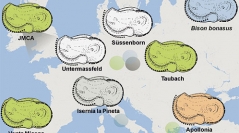

 Comptes Rendus Palevol
16 (7) - Pages 783-794
Comptes Rendus Palevol
16 (7) - Pages 783-794Having arrived 1.8 Ma ago, bison prevailed in the bovid assemblages of the European subcontinent for more than 1.5 Ma. The current geometric morphometric study outlines a framework of ecomorphological differences among several Bison populations of the western Palaearctic, shown by inferences from the tibial and tarsal joint surfaces of their astragalus. Given the principal biomechanical role of this element in the locomotion mechanism, its anatomical features could be linked to diverse functional aspects. In terms of morphological affinity, it is possible to attribute the studied fossil Bison astragalar material to several morphological trends. Shape variation is not explained by size differences and is possibly associated with an open-close habitat gradient, as indicated by the presence of expanded or compressed astragali, respectively. This intragroup spatial and temporal phenotypic diversity among the examined populations could indicate a biogeographic segregation influenced by regional climatic and landscape heterogeneity in the European territory during Pleistocene. Furthermore, a relation to habitat-specific locomotor ecology could be supported, revealing forms with increased cursoriality, operating in open biomes and closed-country dwellers as well.
Bison, Pleistocene, Ecomorphology, Astragalus